check engine Citroen DS4 2011 1.G Owner's Manual
[x] Cancel search | Manufacturer: CITROEN, Model Year: 2011, Model line: DS4, Model: Citroen DS4 2011 1.GPages: 396, PDF Size: 31.05 MB
Page 7 of 396
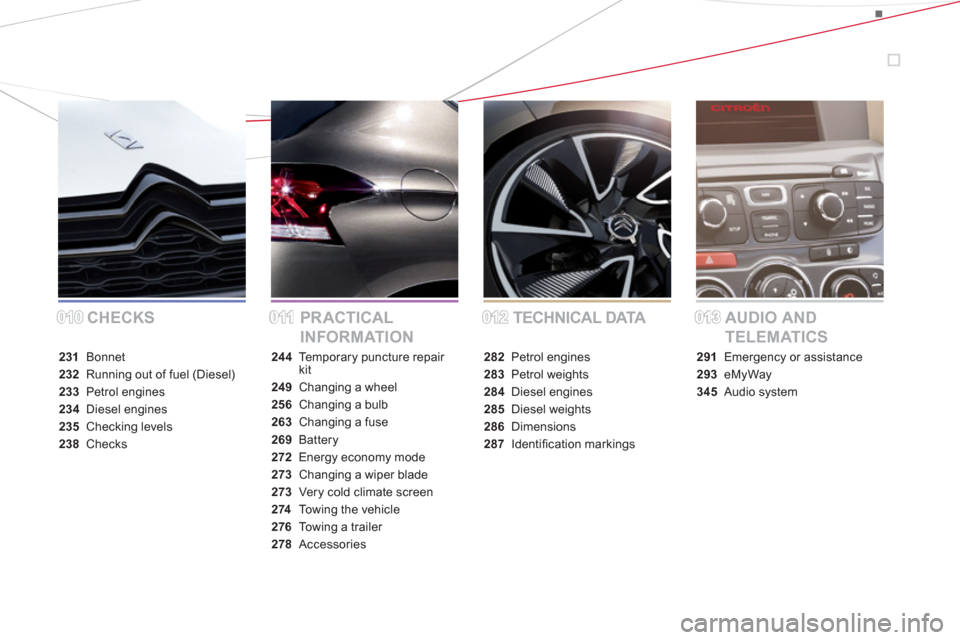
CHECKS PRACTICAL
INFORMATIONTECHNICAL DATA AUDIO AND
TELEMATICS
231 Bonnet
232 Running out of fuel (Diesel)
233 Petrol engines
234 Diesel engines
235 Checking levels
238 Checks244 Temporary puncture repair
kit
249 Changing a wheel
256 Changing a bulb
263 Changing a fuse
269 Battery
272 Energy economy mode
273 Changing a wiper blade
273 Very cold climate screen
274 Towing the vehicle
276 Towing a trailer
278 Accessories282 Petrol engines
283 Petrol weights
284 Diesel engines
285 Diesel weights
286 Dimensions
287 Identifi cation markings291 Emergency or assistance
293 eMyWay
345 Audio system
012012013013010010011011
Page 30 of 396
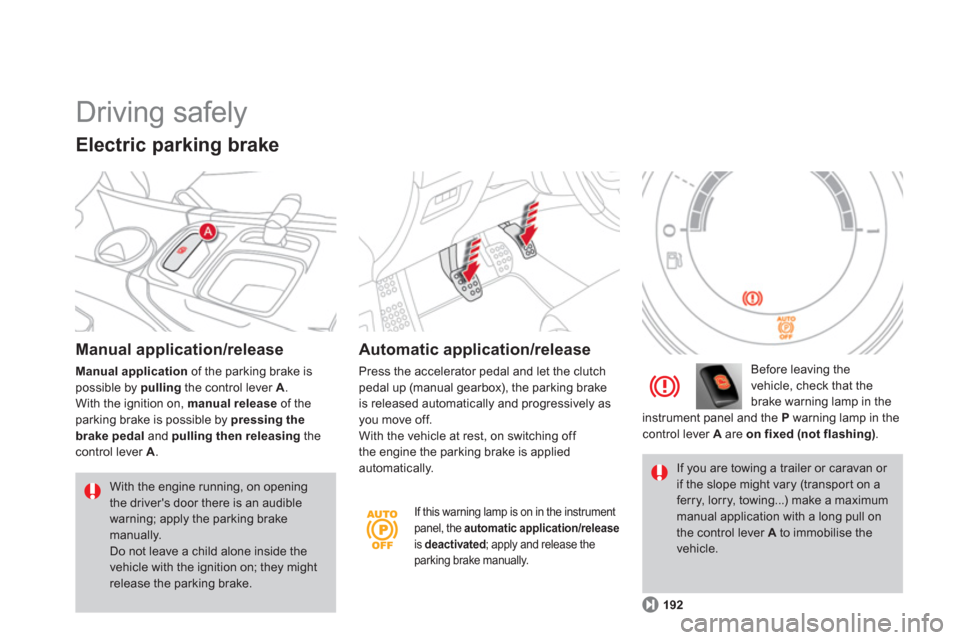
Driving safely
Manual application/release
Manual application
of the parking brake is
possible by pulling
the control lever A
.
With the ignition on, manual release
of the
parking brake is possible by pressing the
brake pedal
and pulling then releasing
the
control lever A
.
Electric parking brake
Automatic application/release
Press the accelerator pedal and let the clutch
pedal up (manual gearbox), the parking brake
is released automatically and progressively as
you move off.
With the vehicle at rest, on switching off
the engine the parking brake is applied
automatically.
If this warning lamp is on in the instrument
panel, the automatic application/release
is deactivated
; apply and release the
parking brake manually.
Before leaving the
vehicle, check that the
brake warning lamp in the
instrument panel and the P
warning lamp in the
control lever A
are on fixed (not flashing)
.
192
With the engine running, on opening
the driver's door there is an audible
warning; apply the parking brake
manually.
Do not leave a child alone inside the
vehicle with the ignition on; they might
release the parking brake. If you are towing a trailer or caravan or
if the slope might vary (transport on a
ferry, lorry, towing...) make a maximum
manual application with a long pull on
the control lever A
to immobilise the
vehicle.
Page 37 of 396
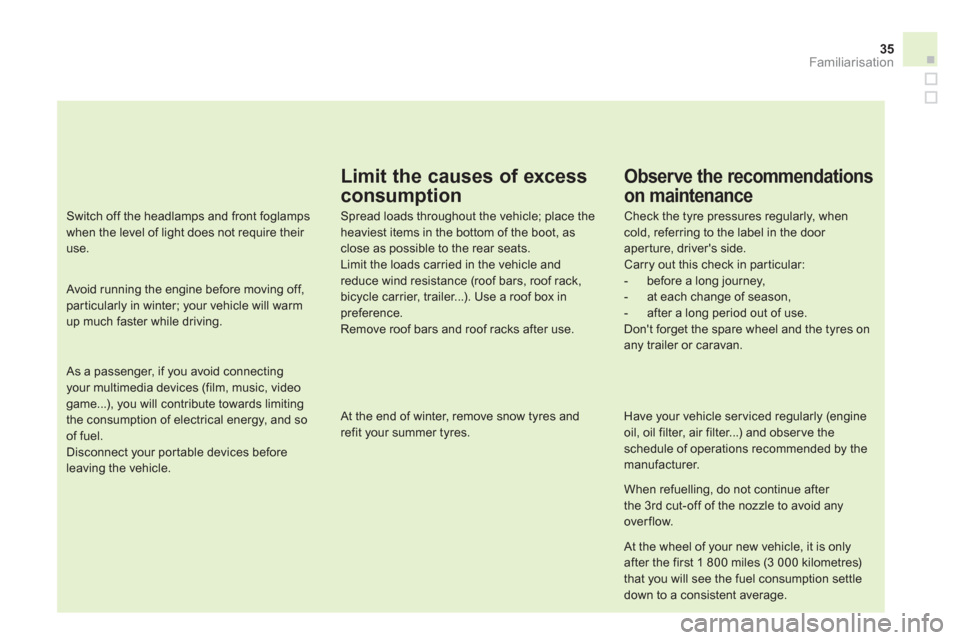
35
Limit the causes of excess
consumption
Spread loads throughout the vehicle; place the
heaviest items in the bottom of the boot, as
close as possible to the rear seats.
Limit the loads carried in the vehicle and
reduce wind resistance (roof bars, roof rack,
bicycle carrier, trailer...). Use a roof box in
preference.
Remove roof bars and roof racks after use.
At the end of winter, remove snow tyres and
refit your summer tyres.
Observe the recommendations
on maintenance
Check the tyre pressures regularly, when
cold, referring to the label in the door
aperture, driver's side.
Carry out this check in par ticular:
- before a long journey,
- at each change of season,
- after a long period out of use.
Don't forget the spare wheel and the tyres on
any trailer or caravan.
Have your vehicle ser viced regularly (engine
oil, oil filter, air filter...) and obser ve the
schedule of operations recommended by the
manufacturer.
When refuelling, do not continue after
the 3 rd cut-off of the nozzle to avoid any
over flow.
At the wheel of your new vehicle, it is only
after the first 1 800 miles (3 000 kilometres)
that you will see the fuel consumption settle
down to a consistent average.
Switch off the headlamps and front foglamps
when the level of light does not require their
use.
Avoid running the engine before moving off,
particularly in winter; your vehicle will warm
up much faster while driving.
As a passenger, if you avoid connecting
your multimedia devices (film, music, video
game...), you will contribute towards limiting
the consumption of electrical energy, and so
of fuel.
Disconnect your portable devices before
leaving the vehicle.
Familiarisation
Page 45 of 396
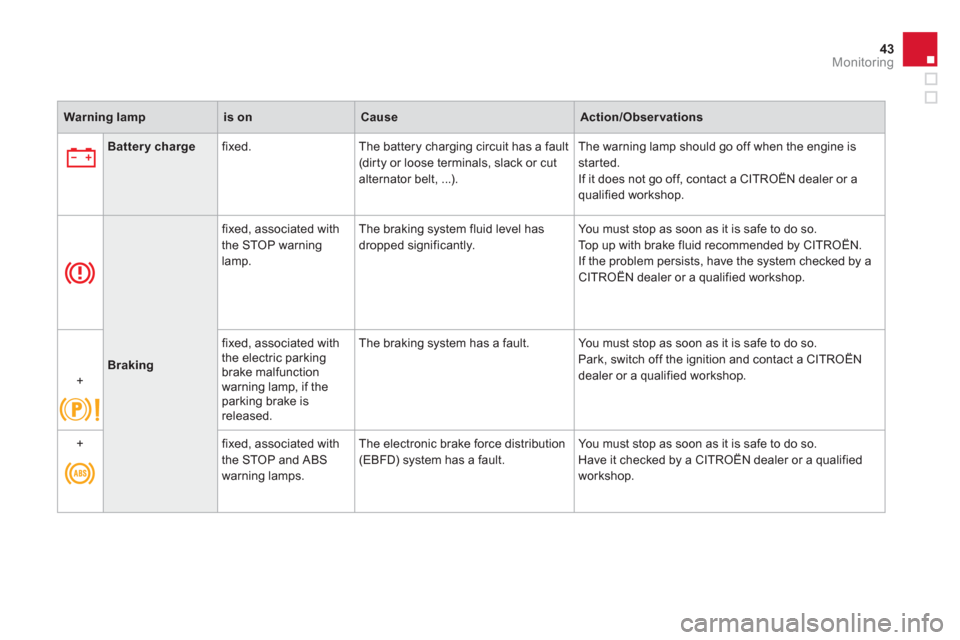
43Monitoring
Warning lamp
is on
Cause
Action/Observations
Battery charge
fixed. The battery charging circuit has a fault
(dir ty or loose terminals, slack or cut
alternator belt, ...). The warning lamp should go off when the engine is
started.
If it does not go off, contact a CITROËN dealer or a
qualified workshop.
Braking
fixed, associated with
the STOP warning
lamp. The braking system fluid level has
dropped significantly. You must stop as soon as it is safe to do so.
Top up with brake fluid recommended by CITROËN.
If the problem persists, have the system checked by a
CITROËN dealer or a qualified workshop.
+
fixed, associated with
the electric parking
brake malfunction
warning lamp, if the
parking brake is
released. The braking system has a fault. You must stop as soon as it is safe to do so.
Park, switch off the ignition and contact a CITROËN
dealer or a qualified workshop.
+
fixed, associated with
the STOP and ABS
warning lamps. The electronic brake force distribution
(EBFD) system has a fault. You must stop as soon as it is safe to do so.
Have it checked by a CITROËN dealer or a qualified
workshop.
Page 47 of 396
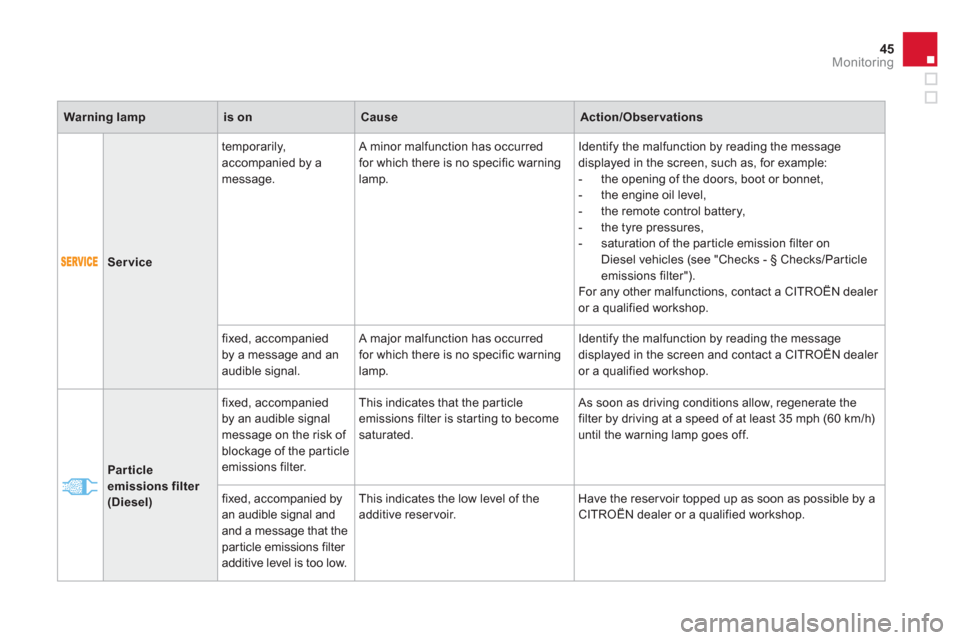
45Monitoring
Service
temporarily,
accompanied by a
message. A minor malfunction has occurred
for which there is no specific warning
lamp. Identify the malfunction by reading the message
displayed in the screen, such as, for example:
- the opening of the doors, boot or bonnet,
- the engine oil level,
- the remote control battery,
- the tyre pressures,
- saturation of the par ticle emission filter on
Diesel vehicles (see "Checks - § Checks/Particle
emissions filter").
For any other malfunctions, contact a CITROËN dealer
or a qualified workshop.
fixed, accompanied
by a message and an
audible signal. A major malfunction has occurred
for which there is no specific warning
lamp. Identify the malfunction by reading the message
displayed in the screen and contact a CITROËN dealer
or a qualified workshop.
Warning lamp
is on
Cause
Action/Observations
Particle
emissions filter
(Diesel)
fixed, accompanied
by an audible signal
message on the risk of
blockage of the particle
emissions filter. This indicates that the par ticle
emissions filter is star ting to become
saturated. As soon as driving conditions allow, regenerate the
filter by driving at a speed of at least 35 mph (60 km/h)
until the warning lamp goes off.
fixed, accompanied by
an audible signal and
and a message that the
particle emissions filter
additive level is too low.
This indicates the low level of the
additive reservoir. Have the reser voir topped up as soon as possible by a
CITROËN dealer or a qualified workshop.
Page 48 of 396
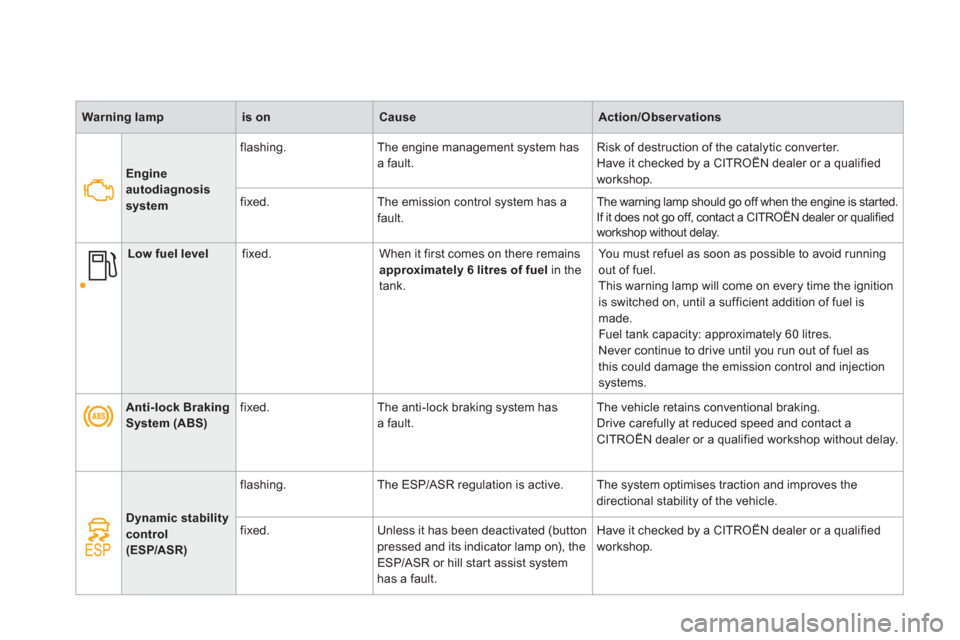
Warning lamp
is on
Cause
Action/Observations
Anti-lock Braking
System (ABS)
fixed. The anti-lock braking system has
a fault. The vehicle retains conventional braking.
Drive carefully at reduced speed and contact a
CITROËN dealer or a qualified workshop without delay.
Dynamic stability
control
(ESP/ASR)
flashing. The ESP/ASR regulation is active. The system optimises traction and improves the
directional stability of the vehicle.
fixed. Unless it has been deactivated (button
pressed and its indicator lamp on), the
ESP/ASR or hill star t assist system
has a fault. Have it checked by a CITROËN dealer or a qualified
workshop.
Engine
autodiagnosis
system
flashing. The engine management system has
a fault. Risk of destruction of the catalytic conver ter.
Have it checked by a CITROËN dealer or a qualified
workshop.
fixed. The emission control system has a
fault. The warning lamp should go off when the engine is star ted.
If it does not go off, contact a CITROËN dealer or qualified
workshop without delay.
Low fuel level
fixed. When it first comes on there remains
approximately 6 litres of
fuel
in the
tank. You must refuel as soon as possible to avoid running
out of fuel.
This warning lamp will come on every time the ignition
is switched on, until a sufficient addition of fuel is
made.
Fuel tank capacity: approximately 60 litres.
Never continue to drive until you run out of fuel as
this could damage the emission control and injection
systems.
Page 49 of 396
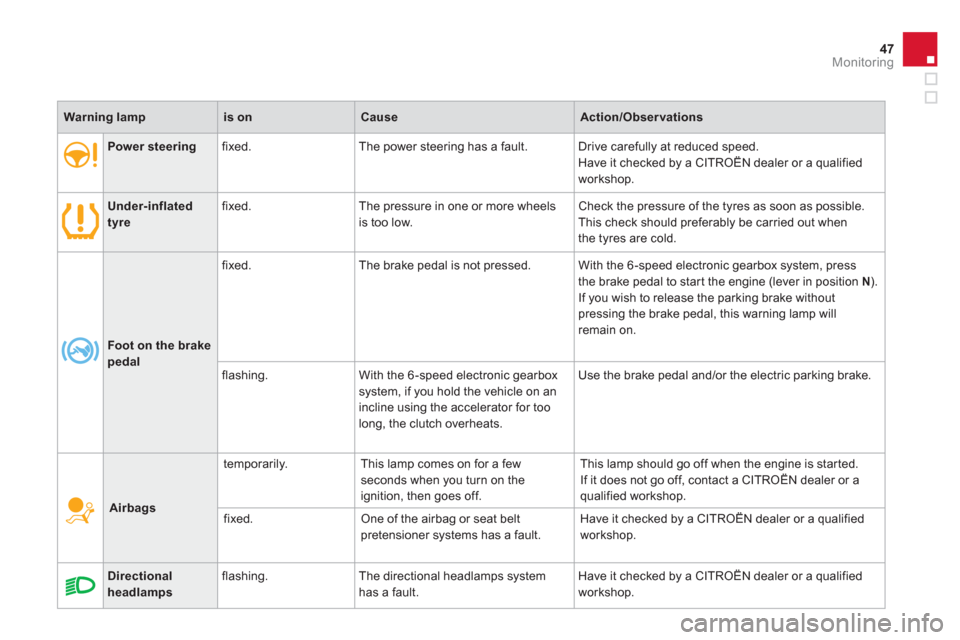
47Monitoring
Power steering
fixed. The power steering has a fault. Drive carefully at reduced speed.
Have it checked by a CITROËN dealer or a qualified
workshop.
Under-inflated
tyre
fixed. The pressure in one or more wheels
is too low. Check the pressure of the tyres as soon as possible.
This check should preferably be carried out when
the tyres are cold.
Directional
headlamps
flashing. The directional headlamps system
has a fault. Have it checked by a CITROËN dealer or a qualified
workshop.
Warning lamp
is on
Cause
Action/Observations
Foot on the brake
pedal
fixed. The brake pedal is not pressed. With the 6 -speed electronic gearbox system, press
the brake pedal to star t the engine (lever in position N
).
If you wish to release the parking brake without
pressing the brake pedal, this warning lamp will
remain on.
flashing. With the 6 -speed electronic gearbox
system, if you hold the vehicle on an
incline using the accelerator for too
long, the clutch overheats. Use the brake pedal and/or the electric parking brake.
Airbags
temporarily. This lamp comes on for a few
seconds when you turn on the
ignition, then goes off. This lamp should go off when the engine is star ted.
If it does not go off, contact a CITROËN dealer or a
qualified workshop.
fixed. One of the airbag or seat belt
pretensioner systems has a fault. Have it checked by a CITROËN dealer or a qualified
workshop.
Page 54 of 396
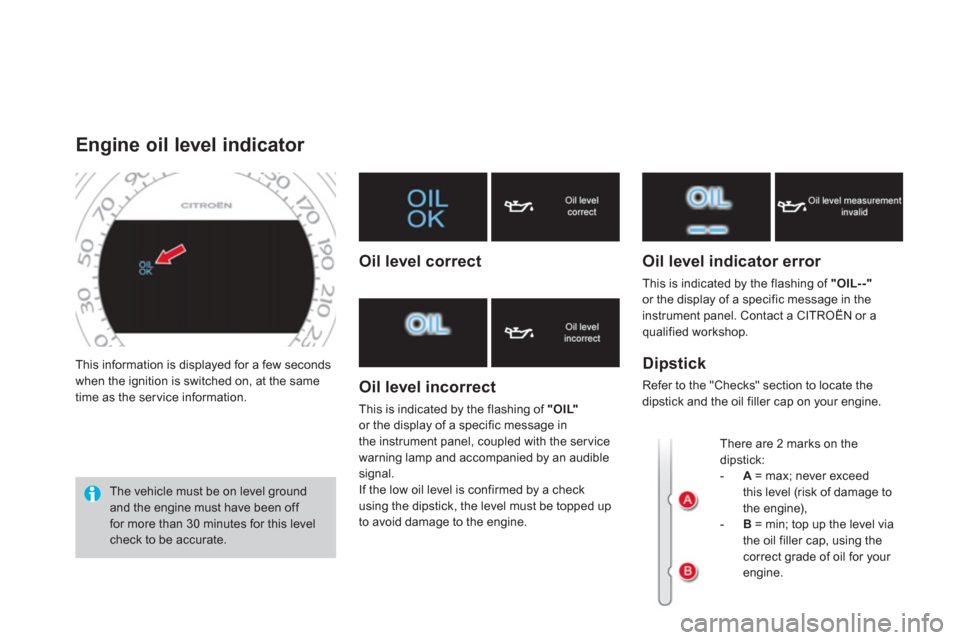
This information is displayed for a few seconds
when the ignition is switched on, at the same
time as the ser vice information.
Engine oil level indicator
The vehicle must be on level ground
and the engine must have been off
for more than 30 minutes for this level
check to be accurate.
Oil level correct
Oil level incorrect
This is indicated by the flashing of "OIL"
or the display of a specific message in
the instrument panel, coupled with the service
warning lamp and accompanied by an audible
signal.
If the low oil level is confirmed by a check
using the dipstick, the level must be topped up
to avoid damage to the engine.
Oil level indicator error
This is indicated by the flashing of "OIL--"
or the display of a specific message in the
instrument panel. Contact a CITROËN or a
qualified workshop.
There are 2 marks on the
dipstick:
- A
= max; never exceed
this level (risk of damage to
the engine),
- B
= min; top up the level via
the oil filler cap, using the
correct grade of oil for your
engine.
Dipstick
Refer to the "Checks" section to locate the
dipstick and the oil filler cap on your engine.
Page 57 of 396
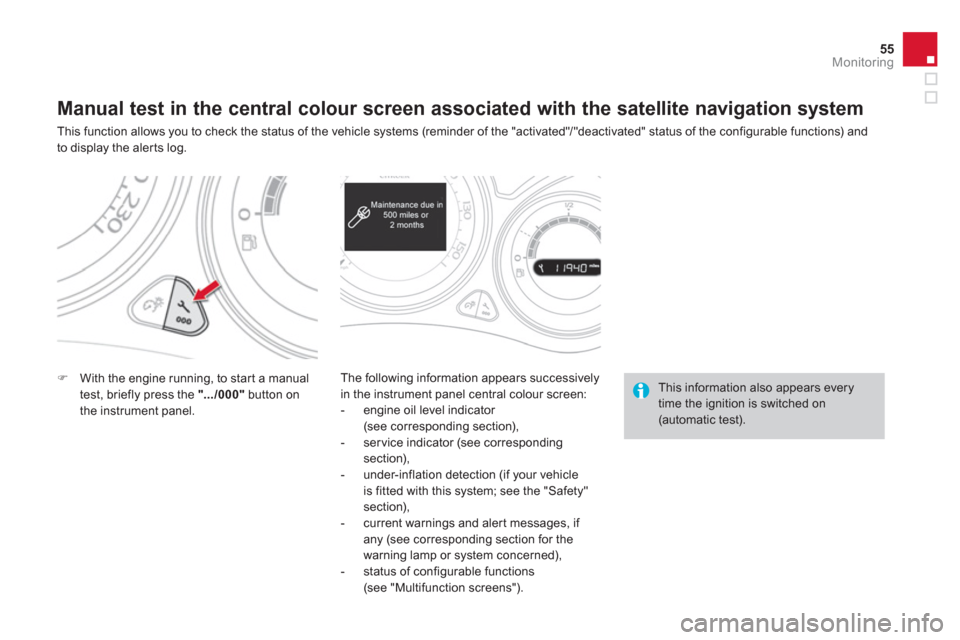
55Monitoring
Manual test in the central colour screen associated with the satellite navigation system
This function allows you to check the status of the vehicle systems (reminder of the "activated"/"deactivated" status of the configurable functions) and
to display the alerts log.
�)
With the engine running, to star t a manual
test, briefly press the ".../000"
button on
the instrument panel. The following information appears successively
in the instrument panel central colour screen:
- engine oil level indicator
(see corresponding section),
- ser vice indicator (see corresponding
section),
- under-inflation detection (if your vehicle
is fitted with this system; see the "Safety"
section),
- current warnings and aler t messages, if
any (see corresponding section for the
warning lamp or system concerned),
- status of configurable functions
(see "Multifunction screens"). This information also appears every
time the ignition is switched on
(automatic test).
Page 81 of 396
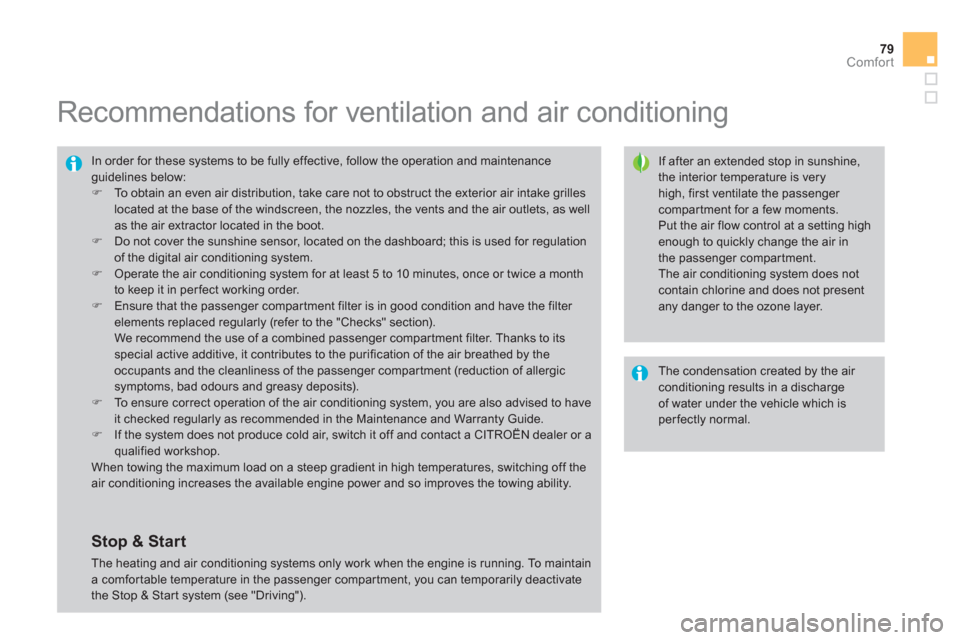
79Comfort
Recommendations for ventilation and air conditioning
If after an extended stop in sunshine,
the interior temperature is very
high, first ventilate the passenger
compartment for a few moments.
Put the air flow control at a setting high
enough to quickly change the air in
the passenger compar tment.
The air conditioning system does not
contain chlorine and does not present
any danger to the ozone layer. In order for these systems to be fully effective, follow the operation and maintenance
guidelines below:
�)
To obtain an even air distribution, take care not to obstruct the exterior air intake grilles
located at the base of the windscreen, the nozzles, the vents and the air outlets, as well
as the air extractor located in the boot.
�)
Do not cover the sunshine sensor, located on the dashboard; this is used for regulation
of the digital air conditioning system.
�)
Operate the air conditioning system for at least 5 to 10 minutes, once or twice a month
to keep it in per fect working order.
�)
Ensure that the passenger compartment filter is in good condition and have the filter
elements replaced regularly (refer to the "Checks" section).
We recommend the use of a combined passenger compartment filter. Thanks to its
special active additive, it contributes to the purification of the air breathed by the
occupants and the cleanliness of the passenger compartment (reduction of allergic
symptoms, bad odours and greasy deposits).
�)
To ensure correct operation of the air conditioning system, you are also advised to have
it checked regularly as recommended in the Maintenance and Warranty Guide.
�)
If the system does not produce cold air, switch it off and contact a CITROËN dealer or a
qualified workshop.
When towing the maximum load on a steep gradient in high temperatures, switching off the
air conditioning increases the available engine power and so improves the towing ability.
The condensation created by the air
conditioning results in a discharge
of water under the vehicle which is
per fectly normal.
Stop & Start
The heating and air conditioning systems only work when the engine is running. To maintain
a comfortable temperature in the passenger compartment, you can temporarily deactivate
the Stop & Star t system (see "Driving").